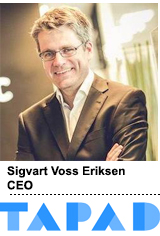 The cross-device company Tapad was an early mover in an ongoing trend where ad tech data companies divest themselves of their media sales businesses.
The cross-device company Tapad was an early mover in an ongoing trend where ad tech data companies divest themselves of their media sales businesses.
In January 2018, Tapad – owned by the Norwegian telco Telenor – offloaded its DSP to Brand Networks, and since then, its peers like Drawbridge and PlaceIQ have attempted similar pirouettes.
“There was a clear consolidation trend in the market starting about two years ago, where generic DSPs emerged as winners,” said Tapad CEO Sigvart Voss Eriksen. Bespoke DSPs dedicated to specific channels lost out to generalized platforms like The Trade Desk, Google and Amazon.
Dropping their media business can be a tough pill to swallow because a DSP processes an entire media buy, generating a lot of revenue. But the DSP itself has a very low profit margin.
Eriksen said data sales have healthier margins, and can be more sustainable without the ad revenue. He said Tapad had its first profitable month in Q4 last year and has grown more profitable since, within a year of spinning out the DSP.
AdExchanger spoke with Eriksen about Tapad’s evolution, and how the business can grow in a new landscape of scaled DSPs and privacy regulations.
AdExchanger: Without the media business, how has the revenue mix changed?
Historically we started off selling to other DSPs. Then came DMPs. Now we have measurement as well, so we’re serving the whole ecosystem.
With a DSP like The Trade Desk you can click to activate cross-device and then there’s a chance to choose Tapad as a provider. Other platforms, we sit behind some cross-device solution, so in that case it isn’t necessarily branded Tapad.
DTC and identity-focused digital-native companies have started coming to us directly.
There are also the large advertisers and brands that have developed more sophisticated data capabilities of their own. Those companies have their own data set they want to verify.
All four of The Trade Desk’s cross-device partners – Crosswise, Tapad, Drawbridge and Adbrain – have been acquired. What does that mean for cross-device technology?
If you listen to [The Trade Desk CEO] Jeff Green and the company’s financial reporting, they put a lot of emphasis on cross-device and identity. They feel there is a need to have a cross-device solution outside of the walled gardens.
But you’re right that the [cross-device] ecosystem hasn’t really increased. There are some small players, but part of it is that it is difficult to have a scaled solution. One challenge is the access to data. And there’s a network effect over time when you exchange and procure data.
What are the data sources for your graph?
RTB data is one source. The other is clients we work with who provide data because contributing to the graph overall benefits them.
It’s different when brands come on. It depends on the type of client. But in the ecosystem there is a general understanding that it’s in everyone’s advantage to share data.
What percent of clients agree to contribute data to the graph?
The majority do decide to, and a large part of our tech partners. It takes a village to build the scale you need.
Does Telenor provide any access to its subscriber data?
From a privacy perspective there are restrictions. We pass them data and they don’t pass data the other way.
If you have deterministic telco data there’s a challenge maintaining privacy with the open ecosystem.
What about Xandr, which is announcing products based on AT&T subscriber data?
Well, GDPR has made it more difficult to co-mingle data in Europe (where Telenor is based). The way we operate, the data input and output is all third-party data.
When an AT&T and Xandr sit together and join their data, the tradeoff on privacy becomes very prominent.
So if Tapad’s data mostly comes from RTB and ecosystem partners, how invested are you in cookie-based solutions like DigiTrust or The Trade Desk’s Unified ID?
We are supportive of those efforts. The industry needs Initiatives that improve our clients’ ability to identify consumers across devices outside of walled gardens.
We actively support The Trade Desk’s ID and are supportive of others.
Are you bringing in new sources beyond cookies and RTB data?
There are a couple areas we have now and are on our road map. One is IoT devices. And I’d put connected TV in there as well. The way the ecosystem operates today is mostly desktop and mobile devices.
Each of the past few years has been “the year of connected TV.” But TV hasn’t quite been cracked.
We do see more CTV identifiers coming into our graph with ad initiatives like Amazon’s Fire TV partnership with dataxu and The Trade Desk. The key is it signals that that part of the ecosystem is opening up, and there will be more chances to apply advertising or measurement across devices and channels. We’ve even started to see car IDs from vehicles with on-board software or apps like Google has.













